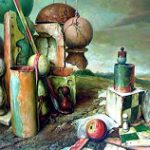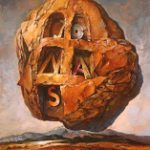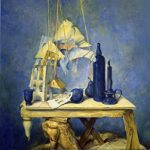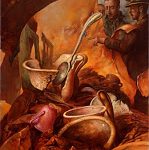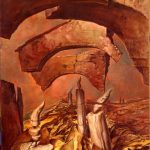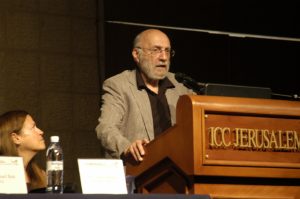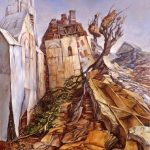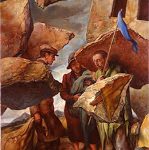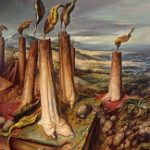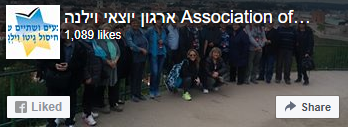Samuel Bak
Samuel Bak (born 12 August 1933) is an American painter and writer who survived the Holocaust and immigrated to Israel in 1948. Since 1993, he has lived in the United States.
Samuel Bak was born in Wilno, Poland, Bak was recognized from an early age as having an artistic talent. He describes his family as secular, but proud of their Jewish identity.
By 1939 when Bak was six years old, the war began and Wilno was transferred from Poland to Lithuania. When Wilno was occupied by the Germans on June 24, 1941, Bak and his family were forced to move into the ghetto. At the age of nine, he held his first exhibition inside the Ghetto. Bak and his mother sought refuge in a Benedictine convent where a Catholic nun named Maria Mikulska tried to help them. After returning to the ghetto, they were deported to a forced labour camp, but took shelter again in the convent where they remained in hiding until the end of the war.
By the end of the war, Samuel and his mother were the only members of his extensive family to survive. His father, Jonas, was shot by the Germans in July 1944, only a few days before Samuel's own liberation. As Bak described the situation, "when in 1944 the Soviets liberated us, we were two among two hundred of Vilna's survivors--from a community that had counted 70 or 80 thousand." Bak and his mother as pre-war Polish citizens were allowed to leave Soviet-occupied Wilno and travel to central Poland, at first settling briefly in Łódź. They soon left Poland and traveled into the American occupied zone of Germany. From 1945 to 1948, he and his mother lived in Displaced Persons camps in Germany. He spent most of this period at the Landsberg am Lech DP camp in Germany. It was there he painted a self-portrait shortly before repudiating his Bar Mitzvah ceremony. Bak also studied painting in Munich during this period, and painted "A Mother and Son", 1947, which evokes some of his dark memories of the Holocaust and escape from Soviet-occupied Poland.
In 1948, Bak and his mother immigrated to Israel. In 1952, he studied art at the Bezalel Academy of Arts and Design in Jerusalem. After serving in the Israel Defense Forces, he continued his studies in Paris (from 1956 at the École nationale supérieure des Beaux-Arts) and spent various periods of time in Rome, Paris, Switzerland and Israel before settling permanently in the United States.
In 2001, Bak returned to Vilnius for the first time and has since visited his hometown several times.
From: Wikipedia
At the end of 2017 Samuel Bak Museum opened in the same building, next to the Tolerance center – there one can find the personal story of the world-known artist and his extraordinary paintings. Samuel Bak Museum.
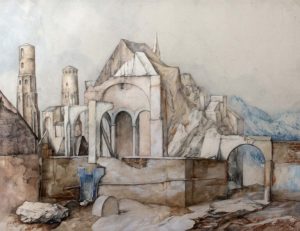 The exhibition "Key to the Childhood City" displayed in Kaunas Picture Gallerys in 2020, is a glimpse into the city of Samuel Bak’s memories – the no longer existent Jerusalem of Lithuania – allowing us to secretly peep through a keyhole. It presents lithographs, drawings and paintings of objects from the artist’s childhood such as the streets of Vilnius that often turn into claustrophobic courtyards located on the strictly demarcated territory of the ghetto. It also represents still life compositions, which form yet another kaleidoscopic puzzle emerging from the depths of the artist’s memory, composed of fragments of memories that are ‘glued’ together to form the world of the past. In Bak’s artwork, glass bottles, cups or vases never form a complete puzzle and there is always a missing element, such as an eyelet or a crack in a glass...
The exhibition "Key to the Childhood City" displayed in Kaunas Picture Gallerys in 2020, is a glimpse into the city of Samuel Bak’s memories – the no longer existent Jerusalem of Lithuania – allowing us to secretly peep through a keyhole. It presents lithographs, drawings and paintings of objects from the artist’s childhood such as the streets of Vilnius that often turn into claustrophobic courtyards located on the strictly demarcated territory of the ghetto. It also represents still life compositions, which form yet another kaleidoscopic puzzle emerging from the depths of the artist’s memory, composed of fragments of memories that are ‘glued’ together to form the world of the past. In Bak’s artwork, glass bottles, cups or vases never form a complete puzzle and there is always a missing element, such as an eyelet or a crack in a glass...
